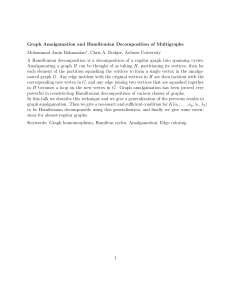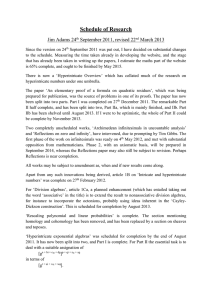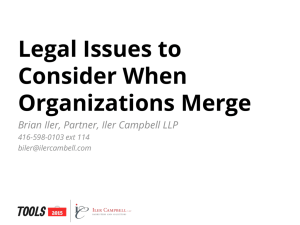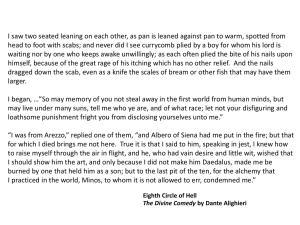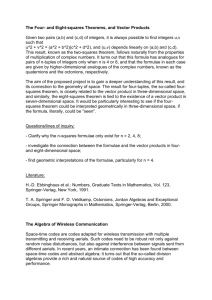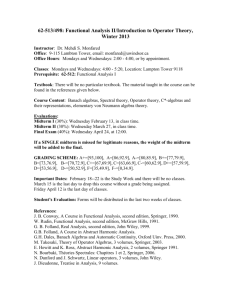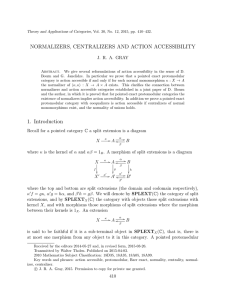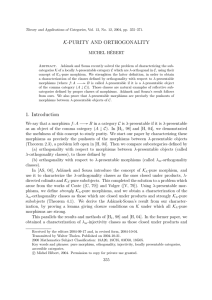THE STRONG AMALGAMATION PROPERTY AND (EFFECTIVE) CODESCENT MORPHISMS DALI ZANGURASHVILI
advertisement
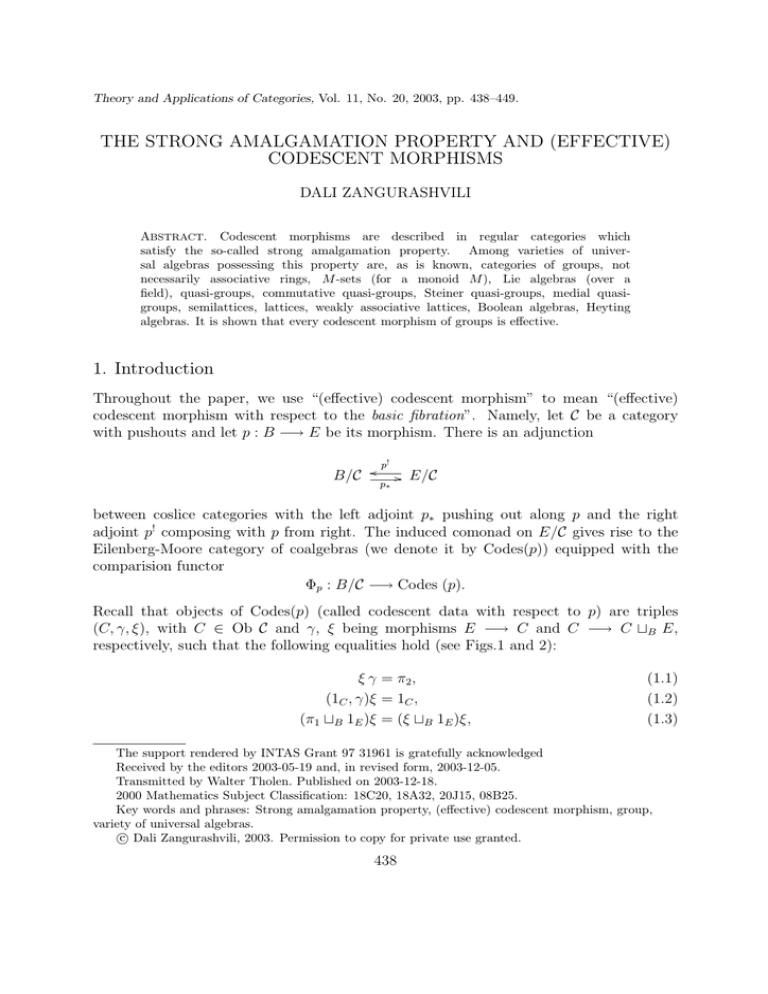
Theory and Applications of Categories, Vol. 11, No. 20, 2003, pp. 438–449.
THE STRONG AMALGAMATION PROPERTY AND (EFFECTIVE)
CODESCENT MORPHISMS
DALI ZANGURASHVILI
ABSTRACT. Codescent morphisms are described in regular categories which
satisfy the so-called strong amalgamation property. Among varieties of universal algebras possessing this property are, as is known, categories of groups, not
necessarily associative rings, M -sets (for a monoid M ), Lie algebras (over a
field), quasi-groups, commutative quasi-groups, Steiner quasi-groups, medial quasigroups, semilattices, lattices, weakly associative lattices, Boolean algebras, Heyting
algebras. It is shown that every codescent morphism of groups is effective.
1. Introduction
Throughout the paper, we use “(effective) codescent morphism” to mean “(effective)
codescent morphism with respect to the basic fibration”. Namely, let C be a category
with pushouts and let p : B −→ E be its morphism. There is an adjunction
B/C o
p!
p∗
/ E/C
between coslice categories with the left adjoint p∗ pushing out along p and the right
adjoint p! composing with p from right. The induced comonad on E/C gives rise to the
Eilenberg-Moore category of coalgebras (we denote it by Codes(p)) equipped with the
comparision functor
Φp : B/C −→ Codes (p).
Recall that objects of Codes(p) (called codescent data with respect to p) are triples
(C, γ, ξ), with C ∈ Ob C and γ, ξ being morphisms E −→ C and C −→ C B E,
respectively, such that the following equalities hold (see Figs.1 and 2):
ξ γ = π2 ,
(1C , γ)ξ = 1C ,
(π1 B 1E )ξ = (ξ B 1E )ξ,
(1.1)
(1.2)
(1.3)
The support rendered by INTAS Grant 97 31961 is gratefully acknowledged
Received by the editors 2003-05-19 and, in revised form, 2003-12-05.
Transmitted by Walter Tholen. Published on 2003-12-18.
2000 Mathematics Subject Classification: 18C20, 18A32, 20J15, 08B25.
Key words and phrases: Strong amalgamation property, (effective) codescent morphism, group,
variety of universal algebras.
c Dali Zangurashvili, 2003. Permission to copy for private use granted.
438
STRONG AMALGAMATION AND (EFFECTIVE) CODESCENT
439
while the functor Φp sends each f : B −→ D to
D B E, π2 , π1 B 1E ,
where π1 and π2 are pushouts of p and f , respectively, along each other.
p
B
p
/E
p
E
π2
ph
C
π1
// C E
B H
ξ
HH
H
(1C ,γ) HH
HH
H# 1C
/C
γ
π1
C
ξ
/E
55
55
55
55
55
π2
55
55
55
55
// C E
55
B O
OOOO
5
OOOξ
B1E 55
π1B1E OOOO O
OOOO' 55
'
/ (C B E)B E
E
γ
γ
p
B
π1 ξ
C B E
Fig. 1
Fig. 2
p is called a codescent (effective codescent) morphism if Φp is full and faithful (an equivalence of categories), i.e. if p∗ is precomonadic (comonadic).
It is well-known that if C is finitely cocomplete, then codescent morphisms are precisely
couniversal regular monomorphisms, i.e. morphisms whose pushouts along any morphisms
are regular monomorphisms [JT].
One of the goals of descent theory is to characterize (effective) codescent morphisms
in particular varieties of universal algebras. There are several results obtained along this
line. For instance, this problem has been completely solved for commutative rings with
units (Joyal-Tierney (unpublished), [M]).
In this paper we describe codescent morphisms in those varieties of algebras (more generally, regular categories) which satisfy the strong amalgamation property and investigate
the problem of the effectiveness of codescent morphisms in the case of groups.
Recall that the strong amalgamation property means that for any pushout square
m
α
/
m / α
with monomorphisms m, α, the morphisms m , α are also monomorphisms and, moreover,
we have
Im m ∩ Im α = Im m α.
Among the varieties of universal algebras possessing this property are, as is known, categories of groups, not necessarily associative rings, M -sets (for a monoid M ), Lie algebras (over a field), quasi-groups, commutative quasi-groups, Steiner quasi-groups, medial
quasi-groups, semilattices, lattices, weakly associative lattices, Boolean algebras, Heyting
/ E of a variety of this kind is codealgebras. We show that a monomorphism p : B /
scent if and only if
440
DALI ZANGURASHVILI
For any congruence R on B and its closure R in E one has
R ∩ (B × B) = R.
This in particular implies that every (regular) monomorphism of M -sets, semilattices,
Boolean algebras and Heyting algebras is codescent. Note that the latter result related
to the case of Boolean algebras was obtained earlier by Makkai (an unpublished work).
The main result of this paper asserts that
Every codescent morphism of groups is effective.
The author gratefully acknowledges useful discussions with George Janelidze on the
subject of this paper.
2. The Strong Amalgamation Property and Codescent Morphisms
Before we begin our discussion, let us recall some definitions [KMPT].
Let C be a category equipped with some proper factorization system (E, M), i.e., a
factorization system which satisfies the conditions E ⊂ Epi C and M ⊂ Mon C.
C is said to satisfy the amalgamation (transferability; congruence extension) property
if for each span
m
α
/
(2.1)
with m, α ∈ M (m ∈ M; m ∈ M and α ∈ E) there exists a commutative square
/
m
α
m / α
(2.2)
with m , α ∈ M (m ∈ M; m ∈ M). C is said to satisfy the strong amalgamation
property (the intersection property of amalgamation) if any span (2.1) with m, α ∈ M
(any commutative diagram (2.2) with m, α, m , α ∈ M) admits a pullback
m
α
m
/
/
α
(2.3)
with m , α ∈ M. In the case of a variety C of universal algebras and M = Mon C,
this definition is equivalent to that of the strong amalgamation property given in the
Introduction, as follows from the arguments given below.
Clearly, C possesses the strong amalgamation property if and only if it satisfies both
the amalgamation and the intersection property of amalgamation. If C admits finite products, then the transferability property is equivalent to the amalgamation and congruence
STRONG AMALGAMATION AND (EFFECTIVE) CODESCENT
441
extension properties 2 . The latter statement remains true if we replace “finite products”
by “pushouts”. In that case all the definitions presented above can be reformulated.
Namely, the amalgamation (transferability; congruence extension) property is equivalent
to the requirement that the class M be stable under pushouts along M-morphisms (any
morphisms; E-morphisms), while the strong amalgamation property is satisfied if and
only if the amalgamation property is fulfilled and pushout (2.2) is also a pullback square
for any m, α ∈ M.
In what follows we make use of the following known result.
2.1. Theorem.
Let C admit pushouts. Then the following conditions are equivalent:
(i) C satisfies the intersection property of amalgamation;
(ii) M consists of all regular monomorphisms.
If, in addition, C satisfies the amalgamation property, then each of (i), (ii) is equivalent
to
(iii) every epimorphism lies in E, and hence E = Epi C.
The implication (i)⇒(ii) is obvious. (ii)⇒(i) is proved in [K], [Ri], [T], while the
equivalence (i)⇔(iii) is proved in [Ri].
Most of investigations related to the question whether concrete categories satisfy the
above-discussed properties deal with the case, where
M = all monomorphisms.
(2.4)
From now on we shall follow assumption (2.4).
2.2. Proposition. Let C be a regular category with pushouts and let C satisfy the strong
amalgamation property. Then the following conditions are equivalent for a monomorphism
/E:
f :B /
(i) f is a codescent morphism;
(ii) f is a couniversal regular monomorphism;
(iii) f is a {Regular epis}-couniversal regular monomorphism3 ;
(iv) f is an {Epis}-couniversal monomorphism;
2
We have to apply the transferability property to both “sides” and after that to take the product.
Similarly to the notion of a couniversal regular monomorphism, for arbitrary morphism classes E and
M one can define a E-couniversal M-morphism as a morphism whose pushout along any E-morphism
lies in M.
3
442
DALI ZANGURASHVILI
(v) for any kernel pair R
α1
α2
/
/ B on B and the kernel pair R
α1
α2
/
/ E of the coequalizer
of (f α1 , f α2 ), the square
R _ _ _ _ _/ R
(α1 ,α2 )
(α1 ,α2 )
(2.5)
B × B / f ×f / E × E
is a pullback.
Each (regular) monomorphism of C is a codescent morphism if and only if C satisfies
additionally the congruence extension (or, equivalently, the transferability property).
If C is (Barr-)exact, then one can replace the first “kernel pair” in (v) by “equivalence
relation”.
Proof. Let us first indicate some properties of the considered categories C. The pair
(Regular epis, Monos) is a factorization system on C. Moreover, by Theorem 2.1 each
monomorphism as well as each epimorphism is regular and for any diagram
α
β
e
/
/
(2.6)
with e being an epimorphism there exists a diagram
α
e
β
α
β
/
/
/
e
(2.7)
/
such that e is also an epimorphism and eα = αe, eβ = βe 4 .
The equivalences (ii)⇔(iii)⇔(iv) obviously follow from the presented properties.
(i)⇔(ii) is the well-known fact proved, for instance, in [JT].
(iv)⇒(v): Let e be a coequalizer of (α1 , α2 ). Then e , the pushout of e along f , is a
4
We first take a pullback e1 of e along α and then the pullback e2 of e along βe1 . e is given by the
composition e2 e1 .
STRONG AMALGAMATION AND (EFFECTIVE) CODESCENT
443
coequalizer of (f α1 , f α2 ). Consider the diagram
A<V<<VVVVVV
VVVV γ
<<<<
VVVV
<<<<
VVVV
VVVV
<<<<
VV
<<<<β2
_
_
_ _ _ V_V/+ R
<<<<
R
f
β1
<<<<α1 α2
<<<<
α1 α2
<<<
f
/E
B /
e
g
(2.8)
e
C _ _ _ _ _ _/ C with any β1 , β2 , γ such that f β1 = α1 γ and f β2 = α2 γ. Then geβ1 = e f β1 = e f β2 =
geβ2 , whence eβ1 = eβ2 , since g being the pushout of f along a (regular) epimorphism
is a monomorphism. Since (α1 , α2 ) is a kernel pair of e, we have a unique morphism
δ : A −→ R such that β1 = α1 δ and β2 = α2 δ. Moreover, α1 f δ = f α1 δ = f β1 = α1 γ
and, similarly, α2 f δ = α2 γ, so that f δ = γ.
(v)⇒(iv): Let gα = gβ and consider e, α, β from diagram (2.7). Clearly, one has
e f α = e f β, which gives a morphism θ with α = α1 θ and β = α2 θ. Therefore eα = eβ,
from which it follows that α = β.
For varieties of universal algebras the condition (v) of Proposition 2.2 clearly takes
the form:
For any congruence R on B and its closure R in E one has
R ∩ (B × B) = R.
2.3. Example. As is known, the varieties of M -sets (for a given monoid M ) [KMPT],
groups [S], not necessarily associative rings [Di], Lie algebras (over a given field) [R],
quasi-groups [YK1], commutative quasi-groups [YK], Steiner quasi-groups [KMPT], medial quasi-groups [JK], semilattices [HK], lattices [Y], [G], weakly associative lattices [FG],
Boolean algebras [DY] and Heyting algebras [D] satisfy the strong amalgamation property.
Moreover, the categories of M -sets [KMPT], semillatices [KMPT], [BL], Boolean algebras
[Si] and Heyting algebras [D] possess the congruence extension property as well. In each
case we give the reference (according to [KMPT]) where the corresponding property is
determined for the first time.
3. Effective Codescent Morphisms of Groups
Proposition 2.2 gives rise to
444
DALI ZANGURASHVILI
/ E be a monomorphism of groups. p is a codescent
3.1. Theorem.
Let p : B /
morphism if and only if for any normal subgroup N of B and its normal closure N in E
one has
N ∩ B = N.
When B is a normal subgroup of E, this is equivalent to the requirement that any normal
subgroup of B be normal in E as well.
Before giving our main result, let us recall some well-known facts related to free
products of groups with an amalgamated subgroup [Ku]. Let H be a group, and
ϕi
/ Gi )i∈I be a family of groups equipped with monomorphisms ϕi . Further, let G
(H /
be a group containing (isomorphic copies of) all Gi , and let
Gi ∩ Gj = H
(3.1)
for i = j (here we identify every h ∈ H with all ϕi (h)). For any i ∈ I and any right
coset of Gi by H, except for H itself, we choose a representative. We denote the set of
all chosen representatives by A. G is a free product of (Gi )i∈I with the amalgamated
subgroup H if and only if every element of G can be uniquely written as a product
h a1 a2 · · · an ,
(3.2)
where n ≥ 0, h ∈ H, all aj lie in A and no two aj , aj+1 belong to the same Gi 5 . Form
(3.2) is called canonical. It is easy to see how an element
a1 a2 · · · am
(3.3)
of G (taken in the uncancellable form) can be reduced to the canonical form. Indeed,
if m = 1 and am ∈ H, then (3.3) is already the desired one. If again m = 1, but
am ∈ Gim \H, then we consider the representation
am = h am
(3.4)
with h ∈ H and am ∈ Gim ∩ A; (3.4) is the canonical form for (3.3). Let m > 1 and
a2 a3 · · · am be already reduced to the required form
a2 a3 · · · am = h a1 a2 · · · an
with aj ∈ Gij ∩ A. If a1 ∈ H, then
(a1 h )a1 a2 · · · an
5
In fact, this criterion remains true even without requirement (3.1)—we only have to replace “set of
representatives” by “system of representatives” and then to specify what kind of products (3.2) and the
uniqueness is meant here.
STRONG AMALGAMATION AND (EFFECTIVE) CODESCENT
445
is clearly the canonical form for (3.3). If a1 ∈ Gi1 \H, then we consider the representation
a1 h = h a1 ,
where h ∈ H and a1 ∈ Gi1 ∩ A. If i1 = i1 , then
h a1 a1 a2 · · · an
is the canonical form for (3.3). If i1 = i1 and a1 a1 ∈ H, then
(h a1 a1 ) a2 · · · an
is the required representation for (3.3). If i1 = i1 and a1 a1 ∈ H, then we have
a1 a1 = h a1 a1
for some h ∈ H and a1 a1 ∈ Gi1 ∩ A; the representation
h a1 a1 a2 · · · an
is the desired form for (3.3).
Now it is clear that if aj1 , aj2 , . . . , ajk are precisely those elements in (3.3) which do
not lie in H and if ijr = ijr+1 (!) for any 1 ≤ r ≤ k − 1, then in the canonical form of (3.3)
we have exactly k factors (except, perhaps, for a coefficient from H) and these factors
belong to Gij1 , Gij2 , . . . , Gijk , respectively. Indeed, in each step of the reduction we either
pick out an H-coefficient from some aj or perform the relevant multiplication. Clearly,
each ajr is changed again by an element from Gijr \H, while no two ajr , ajr+1 can “cancel”
each other.
3.2. Proposition. For any monomorphism p : B /
is surjective up to an isomorphism.
/ E the action of Φp on objects
Proof. Let (C, γ, ξ) be codescent data with respect to p. The pushout in Fig. 1 is the
concatenation of the following two pushouts:
p
B /
/E
/ E/(Ker γ ∩ B)
p
γ(B) /
i
C /
π1
(3.5)
i
/ C γ(B) E/(Ker γ ∩ B)
Here (Ker γ ∩ B) is the normal closure of (Ker γ ∩ B) in E. From (1.2) we conclude that
π1 and thus both p and i are monomorphisms.
446
DALI ZANGURASHVILI
From (1.1) we have
ξ(γ(E)) = π2 (E).
(3.6)
On the other hand, by (1.2) ξ is a split monomorphism. Therefore the homomorphism
γ(E) −→ π2 (E) ≈ E/(Ker γ ∩ B) is an isomorphism and its inverse is the morphism
induced by γ. This in particular implies that (Ker γ ∩ B) = Ker γ and thus diagram
(3.5) takes the form
/E
B /
p
/ γ(E)
p
γ(B) /
i
C /
π1
i
/ C γ(B) γ(E)
If C = γ(E), then (C, γ, ξ) ≈ Φp (B −→ γ(B)).
Suppose now that C = γ(E). Without loss of generality it can be assumed that p is
not an isomorphism. Since we intend to work with the free product of the groups G1 = C
and G2 = γ(E) (as well as with the free product of the groups G1 = C, G2 = γ(E)
and G3 being another copy of γ(E)) with the amalgamated subgroup γ(B), we choose a
representative from each right coset (different from γ(B)) of G1 and G2 (in G3 we choose
the same representatives as in G2 ). Let c ∈ C\γ(E) and let the canonical form of ξ(c) be
written as
(3.7)
ξ(c) = γ(b) a1 a2 · · · an .
We show that if ai ∈ G1 for some i, then
ξ(ai ) ∈ G1 ,
whence, by (1.2)
ξ(ai ) = ai .
Let the canonical form of ξ(ai ) have the form
ξ(ai ) = γ(b )a1 a2 · · · am .
Clearly, by (1.2) m > 0. Suppose that at least one aj lies in G2 . From (1.3) we obtain
= γ(b) · · · a γ(b ) a a · · · a a ··· ,
γ(b) · · · ai−1 ai ai+1 · · ·
i−1
1
2
m
i+1
(3.8)
where the elements in circles are considered as representatives of G3 . The left and right
neighbors of any γ(b ) (if they exist) in the right part of (3.8) lie in different Gi (1 ≤ i ≤ 3).
Therefore, according to the observation preceding this proposition, the canonical form of
STRONG AMALGAMATION AND (EFFECTIVE) CODESCENT
447
the right part of (3.8) necessarily contains a representative from G2 . On the other hand,
the left part of (3.8) is already canonical and does not contain any representative from
G2 , which is a contradiction.
Let C be the smallest subgroup of C containing γ(B) and all elements of G1 which
take part in representation (3.7) for some c ∈ C\γ(E). From (1.2) we obtain
c = γ(b) a1 a2 · · · an ,
where each ai coincides either with ai or with γ(ai ). Thus C is generated by C and γ(E).
Moreover, as we have just proved
ξ C = π1 C .
Therefore, after choosing a set of representatives from the right cosets of C and γ(E)
by γ(B), we conclude that each element of C has precisely one canonical form. Thus
C = C γ(B) γ(E) and (C, γ, ξ) ≈ Φp (γ ), where γ : B −→ C is the homomorphism
induced by γ.
Proposition 3.2 immediately gives rise to
3.3. Theorem.
In the category of groups every codescent morphism is effective.
3.4. Remark. It seems natural to ask what classes of effective codescent morphisms
various comonadicity criteria determine in this case. In this connection, we only observe
/ E , the change-of-cobase functor p∗ preserves (all)
that for a monomorphism p : B /
equalizers if and only if the intersection of any right and left cosets of E by B which
are different from B, contains at most one element. The “if” part is easy to verify. For
the “only if” part we consider the equalities tb = b s and tb1 = b1 s with t, s ∈ E\B,
b, b , b1 , b1 ∈ B and choose a diagram
B
~ A
~~ i2 AAAi3
~
AA
~
~~~ γ
α /
/
/
/K
C
D
i1
β
with monomorphisms i1 , i2 , i3 such that the bottom part is an equalizer diagram and,
moreover, there exist d, d ∈ D\B with b−1 α(d) = b−1
1 β(d) and α(d )b = β(d )b1 . It is
easy to see that for the element x = d td of D B E we have (α B 1E )(x) = (β B 1E )(x).
Hence x = (γ B 1E )(y) for some y ∈ C B E. If we choose representatives of the right
cosets of C by B, then their images under γ can be taken as representatives of (some)
right cosets of D. The canonical form of y necessarily ends in an element c from C. We
have γ(c) = b d for some b ∈ B and therefore α(d) = β(d) and b = b1 , b = b1 .
In particular, when B is normal in E, p∗ preserves equalizers if and only if B is trivial.
448
DALI ZANGURASHVILI
References
[BL] G. Bruns and H. Lakser, Injective hulls of semilattices, Canad. Math. Bull. 13
(1970), 115–118.
[D] A. Day, Varieties of Heyting algebras, II (Amalgamation and injectivity) (unpublished note).
[Di] C. E. Dididze, Non-associative free sums of algebras with an amalgamated subalgebra, Mat. Sb. N. S. 43 (85)(1957), 379–396 (in Russian).
[DY] Ph. Dwinger and F. M. Yaqub, Generalized free products of Boolean algebras
with an amalgamated subalgebra, Nederl. Akad. Wetensch. Proc. Ser. A 66 =
Indag. Math. 25 (1963), 225–231.
[G] G. Grätzer, General lattice theory, Lehrbücher und Monographien aus dem Gebiete der exakten Wissenchaften, Mathematische Reihe, Band 52, BirkhauserVerlag, Basel-Stuttgart, 1978.
[FG] E. Fried and G. Grätzer, Partial and free weakly associative lattices, Houston
J. Math. 2 (1976), 501–512.
[HK] A. Horn and N. Kimura, The category of semilattices, Algebra Universalis 1
(1971/72), 26–38.
[YK] J. Ježek and T. Kepka, Varieties of abelian quasigroups, Czechoslovak Math. J.
27 (102)(1977), 473–503.
[YK1] J. Ježek and T. Kepka, Varieties of quasigroups determined by short strictly
balanced identities, Czechoslovak Math. J. 29 (104)(1979), 84–96.
[J] B. Jonsson, Homogeneous universal relational systems, Math. Scand. 8 (1960),
137–142.
[JT] G. Janelidze and W. Tholen, Facets of descent, I. Appl. Cat. Str. 2 (1994), 1–37.
[K] G. M. Kelly, Monomorphisms, epimorphisms and pull-backs, J. Austral. Math.
Soc. 9 (1969), 124–142.
[Ku] A. G. Kuroš, Theory of groups. “Nauka”, Moscow, 1967 (in Russian).
[KMPT] B. W. Kiss, L. Marki, P. Pröhle and W. Tholen, Categorical algebraic properties.
A compendium on amalgamation, congruence extension, epimorphisms, residual
smallness and injectivity, Studia Scientiarum Mathematicarum Hungarica 18
(1983), 79–141.
STRONG AMALGAMATION AND (EFFECTIVE) CODESCENT
449
[M] B. Mesablishvili, Pure morphisms of commutative rings are effective descent
morphisms for modules - a new proof, Theory and Applications of Categories,
No. 3, 7 (2000), 38–42.
[R] G. A. Reid, Epimorphisms and surjectivity, Invent. Math. 9 (1969/70), 295–307.
[Ri] C. M. Ringel, The intersection property of amalgamations, J. Pure Appl. Algebra
2 (1972), 341–342.
[S] O. Schreier, Die Untergruppen der freien Gruppen, Abh. Math. Sem. Univ. Hamburg 5 (1927), 161–183.
[Si] R. Sikorski, A theorem on extensions of homomorphisms, Ann. Soc. Polon.
Math. 21 (1948), 332–335.
[T] W. Tholen, Amalgamations in categories, Algebra Universalis 14 (1982), 391–
397.
Laboratory of Synergetics, Technical University of Georgia
77 Kostava str., 380075, Tbilisi, Georgia
Mathematical Institute of the Academy of Science
1 Aleksidze Str., 0193, Tbilisi, Georgia
Email: dalizan@rmi.acnet.ge
This article may be accessed via WWW at http://www.tac.mta.ca/tac/ or by anonymous ftp at ftp://ftp.tac.mta.ca/pub/tac/html/volumes/11/20/11-20.{dvi,ps}
THEORY AND APPLICATIONS OF CATEGORIES (ISSN 1201-561X) will disseminate articles that
significantly advance the study of categorical algebra or methods, or that make significant new contributions to mathematical science using categorical methods. The scope of the journal includes: all areas of
pure category theory, including higher dimensional categories; applications of category theory to algebra,
geometry and topology and other areas of mathematics; applications of category theory to computer
science, physics and other mathematical sciences; contributions to scientific knowledge that make use of
categorical methods.
Articles appearing in the journal have been carefully and critically refereed under the responsibility
of members of the Editorial Board. Only papers judged to be both significant and excellent are accepted
for publication.
The method of distribution of the journal is via the Internet tools WWW/ftp. The journal is archived
electronically and in printed paper format.
Subscription information. Individual subscribers receive (by e-mail) abstracts of articles as
they are published. Full text of published articles is available in .dvi, Postscript and PDF. Details will
be e-mailed to new subscribers. To subscribe, send e-mail to tac@mta.ca including a full name and
postal address. For institutional subscription, send enquiries to the Managing Editor, Robert Rosebrugh,
rrosebrugh@mta.ca.
Information for authors. The typesetting language of the journal is TEX, and LATEX is the
preferred flavour. TEX source of articles for publication should be submitted by e-mail directly to an
appropriate Editor. They are listed below. Please obtain detailed information on submission format and
style files from the journal’s WWW server at http://www.tac.mta.ca/tac/. You may also write to
tac@mta.ca to receive details by e-mail.
Editorial board.
John Baez, University of California, Riverside: baez@math.ucr.edu
Michael Barr, McGill University: barr@barrs.org, Associate Managing Editor
Lawrence Breen, Université Paris 13: breen@math.univ-paris13.fr
Ronald Brown, University of Wales Bangor: r.brown@bangor.ac.uk
Jean-Luc Brylinski, Pennsylvania State University: jlb@math.psu.edu
Aurelio Carboni, Università dell Insubria: aurelio.carboni@uninsubria.it
Valeria de Paiva, Palo Alto Research Center: paiva@parc.xerox.com
Martin Hyland, University of Cambridge: M.Hyland@dpmms.cam.ac.uk
P. T. Johnstone, University of Cambridge: ptj@dpmms.cam.ac.uk
G. Max Kelly, University of Sydney: maxk@maths.usyd.edu.au
Anders Kock, University of Aarhus: kock@imf.au.dk
Stephen Lack, University of Western Sydney: s.lack@uws.edu.au
F. William Lawvere, State University of New York at Buffalo: wlawvere@buffalo.edu
Jean-Louis Loday, Université de Strasbourg: loday@math.u-strasbg.fr
Ieke Moerdijk, University of Utrecht: moerdijk@math.uu.nl
Susan Niefield, Union College: niefiels@union.edu
Robert Paré, Dalhousie University: pare@mathstat.dal.ca
Robert Rosebrugh, Mount Allison University: rrosebrugh@mta.ca, Managing Editor
Jiri Rosicky, Masaryk University: rosicky@math.muni.cz
James Stasheff, University of North Carolina: jds@math.unc.edu
Ross Street, Macquarie University: street@math.mq.edu.au
Walter Tholen, York University: tholen@mathstat.yorku.ca
Myles Tierney, Rutgers University: tierney@math.rutgers.edu
Robert F. C. Walters, University of Insubria: robert.walters@uninsubria.it
R. J. Wood, Dalhousie University: rjwood@mathstat.dal.ca
